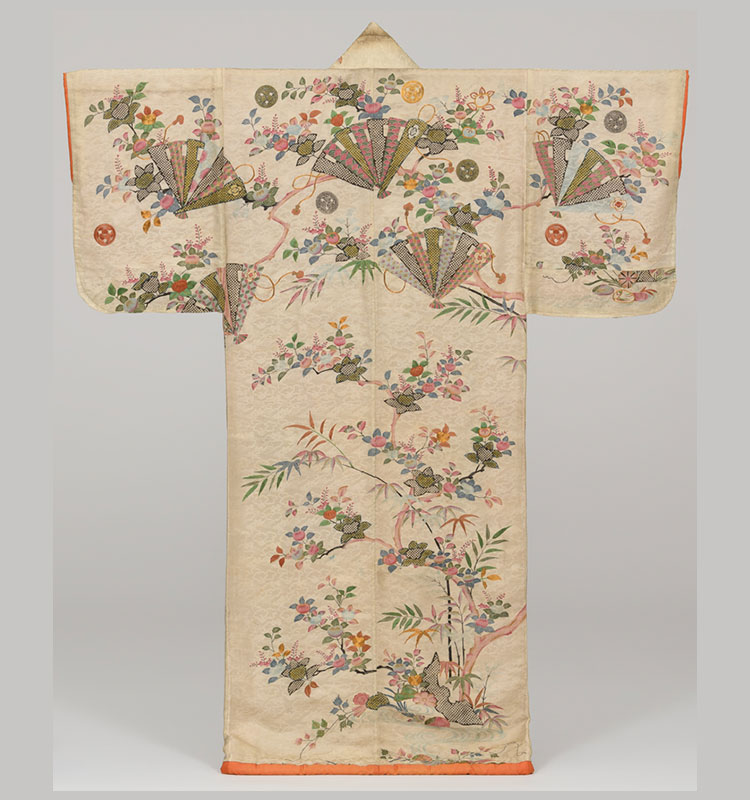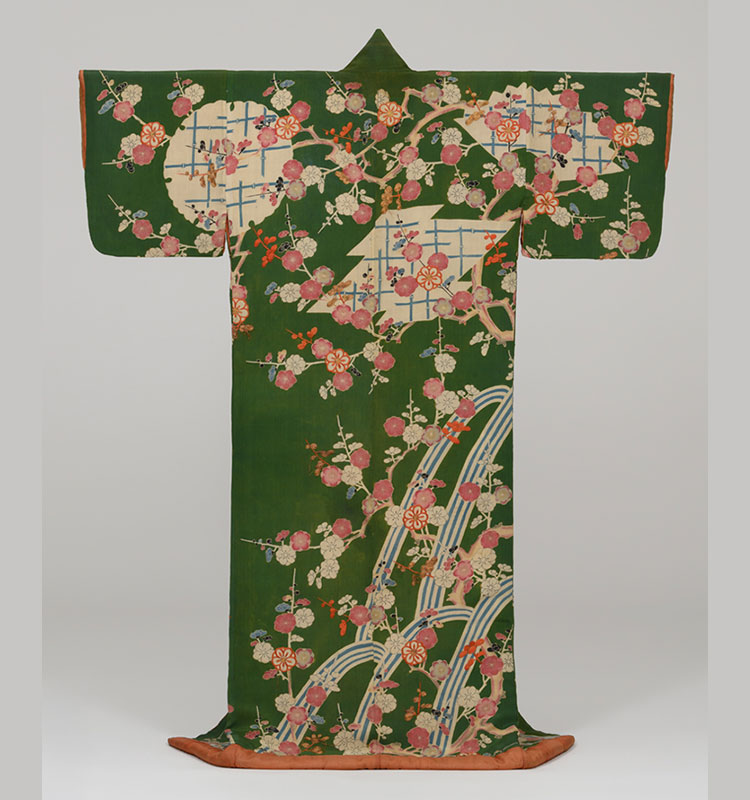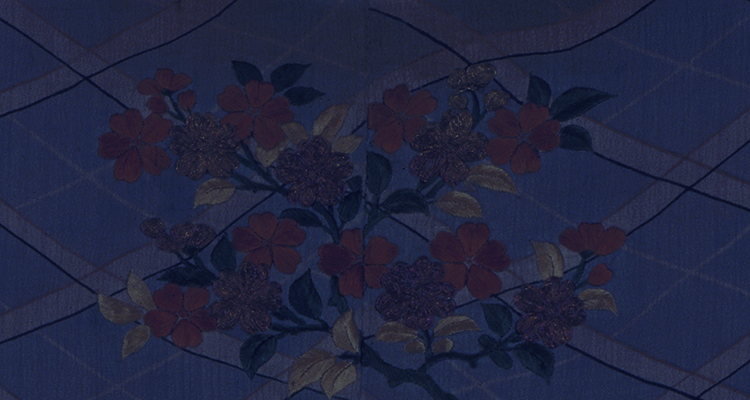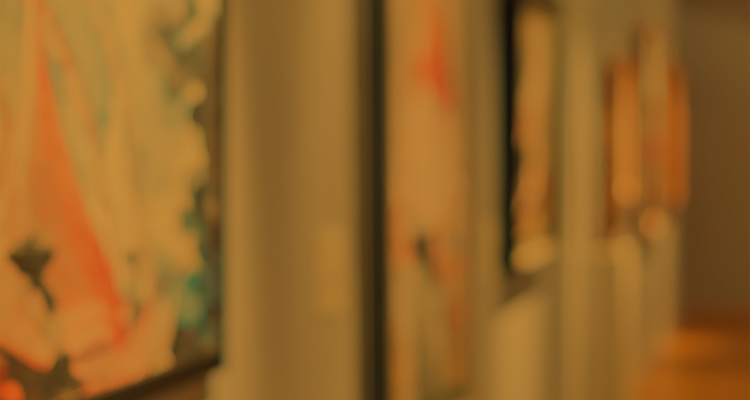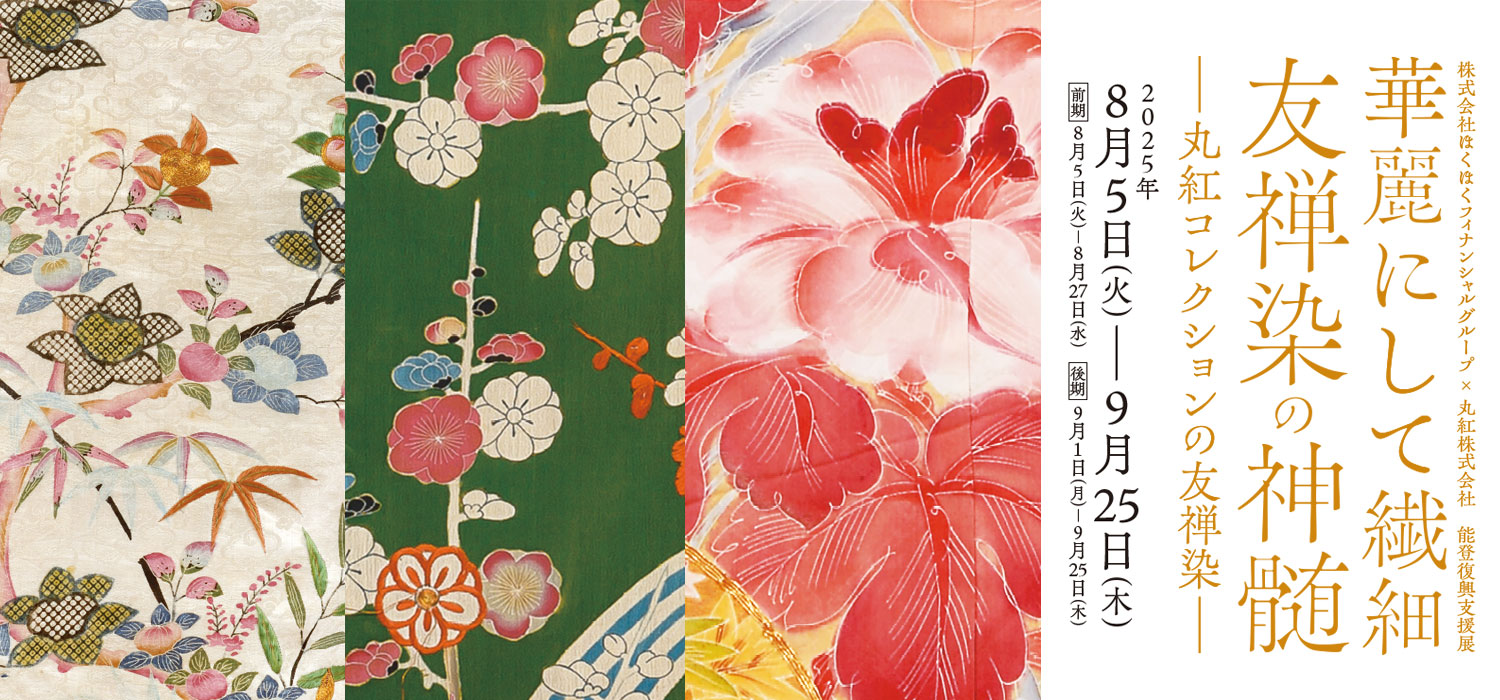
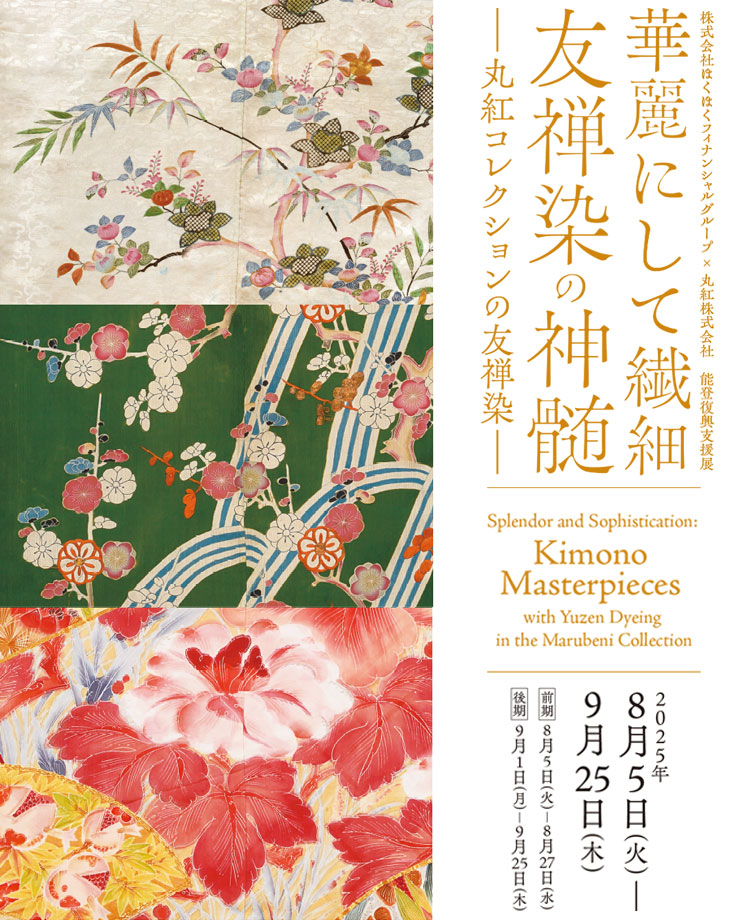
Exhibition企画展
株式会社ほくほくフィナンシャルグループ×丸紅株式会社
能登復興支援展
華麗にして繊細 友禅染の神髄
―丸紅コレクションの友禅染―
会期:2025年8月5日(火)~9月25日(木)
(前期)8月5日(火)~8月27日(水)
(後期)9月1日(月)~9月25日(木)
友禅染は江戸時代17世紀末に生まれた染色技法で、それまで一般的な染色技法だった絞り染を中心とする技法に比べて、はるかに多色で繊細な表現を可能にしたことで、町人女性の小袖を豊かに彩りました。18世紀にその盛期を迎えた友禅染は、明治時代以降に合成染料を用いた新しい色彩と技術が反映され、大正・昭和と変化しつつ歴史を重ねていきました。また、友禅染は京都を中心に発達し、京都からその技法が伝わった金沢においては、技術の極みともいえる友禅染掛幅(かけふく)(※)が誕生しました。そして、明治以降は「加賀友禅」の名で伝統的工芸品としても定着しています。本展では、丸紅コレクションを中心とした江戸時代の友禅染の名品である、小袖や友禅染掛幅、昭和時代の友禅作家によって制作された作品を展示します。時代に応じて華麗に変化した染色技術と繊細な模様表現をお楽しみください。
(※)床の間などに掛けて鑑賞する絵や書のことを指し、掛軸の別称。
newsお知らせ
-
2025/07/07
華麗にして繊細 友禅染の神髄 ―丸紅コレクションの友禅染― 開催情報を更新しました。
-
2025/02/17
『ボッティチェリ 美しきシモネッタ』特別公開展 開催情報を更新しました。
-
2025/01/30
「八幡垣睦子-古裂のメタモルフォーゼ」についての動画をアップしました。
-
2024/11/12
「格式の美 ―丸紅コレクションの能装束―」についての動画をアップしました。
-
2024/10/28
八幡垣睦子-古裂のメタモルフォーゼ 開催情報を更新しました。
-
2024/08/26
格式の美 ―丸紅コレクションの能装束― 開催情報を更新しました。
-
2024/07/16
丸紅コレクションのデータベースを公開しました。
-
2024/04/08
和フリカ—第三の美意識を求めて― 開催情報を更新しました。
-
2024/03/21
「『ふしみ殿御あつらへ』小袖裂の復元制作と墨書きの謎」についての動画をアップしました。
-
2024/01/26
源氏物語展「女房装束を見る・語る―源氏物語の世界―」についての動画をアップしました。
-
2024/01/23
ご好評につき、源氏物語展の図録を再販売します。(売り切れ次第終了)
-
2024/01/13
丸紅ギャラリーへのアクセス情報を更新しました。「竹橋駅出入口に関するお知らせ」もご確認ください。
-
2023/11/30
「ふしみ殿御あつらへ」小袖裂と復元小袖-墨書と裂から分かる桃山時代の小袖制作- 開催情報を更新しました。
-
2023/11/01
源氏物語 よみがえった女房装束の美 開催情報を更新しました。
-
2023/10/25
「濱野年宏展 オープニング記念コンサート」についての動画をアップしました。
-
2023/08/14
濱野年宏 伝統と現代のハーモニー 聖徳太子絵伝四季図大屏風(中宮寺蔵)と新作 開催情報を更新しました。
-
2023/06/30
開館記念展Ⅳ:シンポジウム「古今に繋がる図案―革新性と多様性―」についての動画をアップしました。
-
2023/04/17
開館記念展Ⅳ:染織図案とあかね會 ―その思いを今につむぐ― 開催情報を更新しました。
-
2023/01/16
開館記念展Ⅲ:講演会「ボッティチェリ≪美しきシモネッタ≫」についての動画をアップしました。
-
2022/11/25
Google Arts&Cultureに丸紅ギャラリーのページを開設しました。
-
2022/11/01
開館記念展Ⅲ:ボッティチェリ特別展《美しきシモネッタ》 イベント情報を更新しました。
-
2022/11/01
開館記念展Ⅲ:ボッティチェリ特別展《美しきシモネッタ》 開催情報を更新しました。
-
2022/07/25
開館記念展Ⅰ:講演会① 「丸紅コレクションの成り立ち」、開館記念展Ⅰ:講演会② 「丸紅ギャラリー開館記念展I - 日仏近代絵画の響き合い - の見どころ」、開館記念展Ⅱ:講演会 「『美』の継承-きもの文化を未来に繋ぐ」についての動画をアップしました。
-
2022/05/10
開館記念展Ⅱ:「美」の追求と継承 ─丸紅コレクションのきもの─ イベント情報を更新しました。
-
2022/05/10
開館記念展Ⅱ:「美」の追求と継承 ─丸紅コレクションのきもの─ 開催情報を更新しました。
-
2021/10/01
開館記念展Ⅰ:「日仏近代絵画の響き合い」イベント情報を更新しました。
-
2021/10/01
開館記念展Ⅰ:「日仏近代絵画の響き合い」開催情報を更新しました。
-
2021/10/01
インスタグラム公式アカウントを開設しました。
-
2021/10/01
WEBサイトをオープンしました。
accessアクセス
東京都千代田区大手町一丁目4番2号 丸紅ビル3階
地下鉄「竹橋駅」3b 出口より徒歩2分(東京メトロ東西線)
地下鉄「大手町駅」C2b 出口より徒歩6分(東京メトロ千代田線)
地下鉄「神保町駅」A9 出口より徒歩7分(東京メトロ半蔵門線・都営地下鉄新宿線・三田線)
※当館には駐車場がございません。近隣の有料駐車場をご利用いただくか、公共交通機関をご利用ください。




